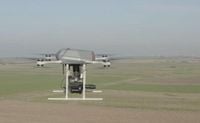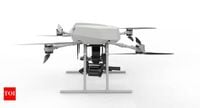Tensions between India and Pakistan escalated dramatically following a significant aerial incursion by Pakistan on the night of May 8, 2025. In a press briefing conducted by the Ministry of External Affairs (MEA) and armed forces officials, Colonel Sofiya Qureshi revealed that Pakistan deployed a swarm of 300 to 400 unmanned aerial vehicles (UAVs) across the entire western border, from Leh in the north to Sir Creek in the south. This coordinated operation aimed to target key military infrastructure in India.
Colonel Qureshi stated, "On the night of May 8, the Pakistani army violated Indian airspace multiple times with the clear intention of targeting our military installations. They also resorted to firing heavy-caliber weapons along the Line of Control." The attempted infiltration spanned 36 locations, indicating a multi-pronged effort to overwhelm Indian air defenses and potentially gather intelligence on sensitive military sites.
Despite the scale of the attack, Indian forces managed to neutralize the majority of the drones using both kinetic (missile interception) and non-kinetic (electronic warfare) methods. Preliminary forensic analysis of the downed drones indicated that they were Turkish-made Asisguard Songar armed UAVs. Colonel Qureshi confirmed, "We are analyzing the wreckage, and initial reports suggest these were Turkey's Songar drones." This incident marks a significant escalation in cross-border hostilities.
The Asisguard Songar is Turkey's first indigenously developed armed drone system, manufactured by the Ankara-based defense company Asisguard. Launched in April 2019, the Songar was delivered to the Turkish Armed Forces after successful testing in February 2020. It is designed for both autonomous and remote-controlled operations, making it suitable for asymmetric warfare.
Key features of the Songar include its armed capability, where it can be equipped with a stabilized 5.56 mm NATO standard assault rifle, allowing for precision engagement of personnel and light vehicles. The drone can carry up to 200 rounds of ammunition and, in more recent versions, can integrate with 40 mm grenade launchers and 81 mm mortar grippers for air-dropping munitions.
Equipped with high-resolution electro-optical and infrared cameras, the Songar provides real-time video and telemetry data, crucial for intelligence, surveillance, and reconnaissance missions in all weather conditions. It typically has a maximum takeoff weight of around 45 kg, a flight time of 25-30 minutes without payload, and an operational range of 3-5 km. The drone can operate at altitudes up to 2,800 meters above sea level and 400 meters above ground.
Reports suggest that the Songar drones utilized during the incursion were equipped with various armaments tailored for different combat scenarios. The system can broadcast real-time video and operate within a mission radius of up to 5 km, indicating that the Pakistani drones were launched from areas very close to the border with India.
The drone's capabilities for coordinated attacks with other military assets, such as troops or additional drones, allow for simultaneous strikes from multiple directions, a tactic employed during the May 8 assault to overwhelm Indian defenses. This type of warfare represents a significant shift in military strategy in the region.
As tensions rise, Turkey has publicly extended its support to Pakistan. Turkish President Recep Tayyip Erdogan expressed solidarity with Pakistan during a phone call with Prime Minister Shehbaz Sharif, stating, "Turkey is ready to do what it can to prevent the tensions from escalating, and that his diplomatic contacts in that regard would continue." Erdogan also supported Pakistan's proposal for an international investigation into the April 22 Pahalgam terror attack, which resulted in the deaths of 26 civilians.
In a social media post, Erdogan voiced concern over rising civilian casualties, saying, "We are concerned that the tension between Pakistan and India could escalate into open conflict with missile attacks that have resulted in the martyrdom of numerous civilians." He emphasized Turkey's commitment to reducing tensions and opening channels for dialogue before the situation becomes irreversible.
The backdrop of this military escalation follows the tragic Pahalgam terror attack, which has heightened tensions between the two nations. As India continues to bolster its air defense capabilities, including systems like Akash, MRSAM, and S-400, the effectiveness of these technologies was demonstrated when Indian forces successfully intercepted most of the drones before they could inflict substantial damage.
While the incident on May 8 signifies a notable increase in drone warfare tactics within the subcontinent, it also highlights the ongoing technological arms race between India and Pakistan. The deployment of Turkish drones by Pakistan raises questions about the future of military engagements in the region and the potential for further escalations.
As the situation develops, both nations remain on high alert, with military and diplomatic channels working to navigate the complex landscape of Indo-Pakistan relations. The international community watches closely, hoping for a resolution to prevent further conflict.






